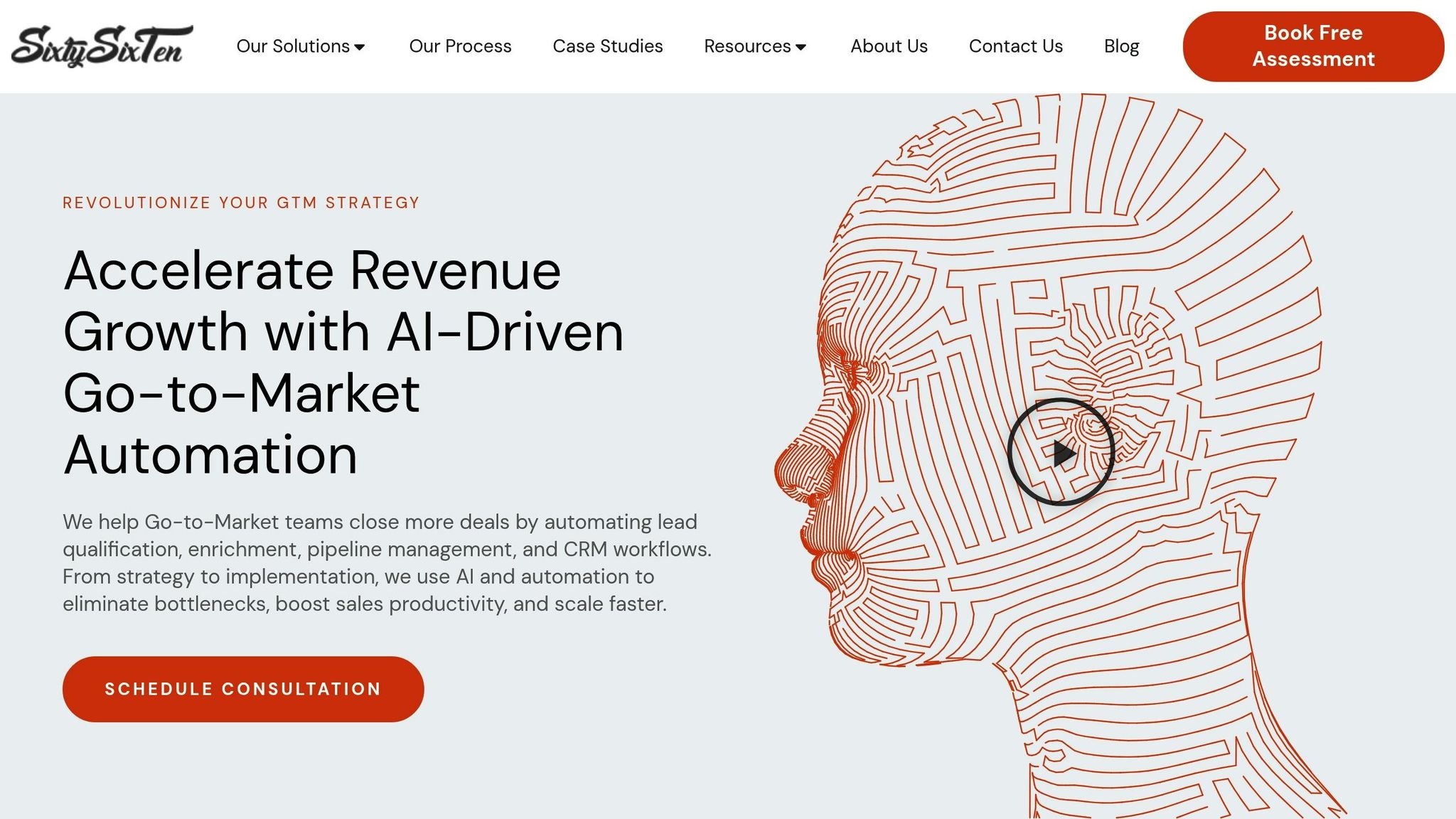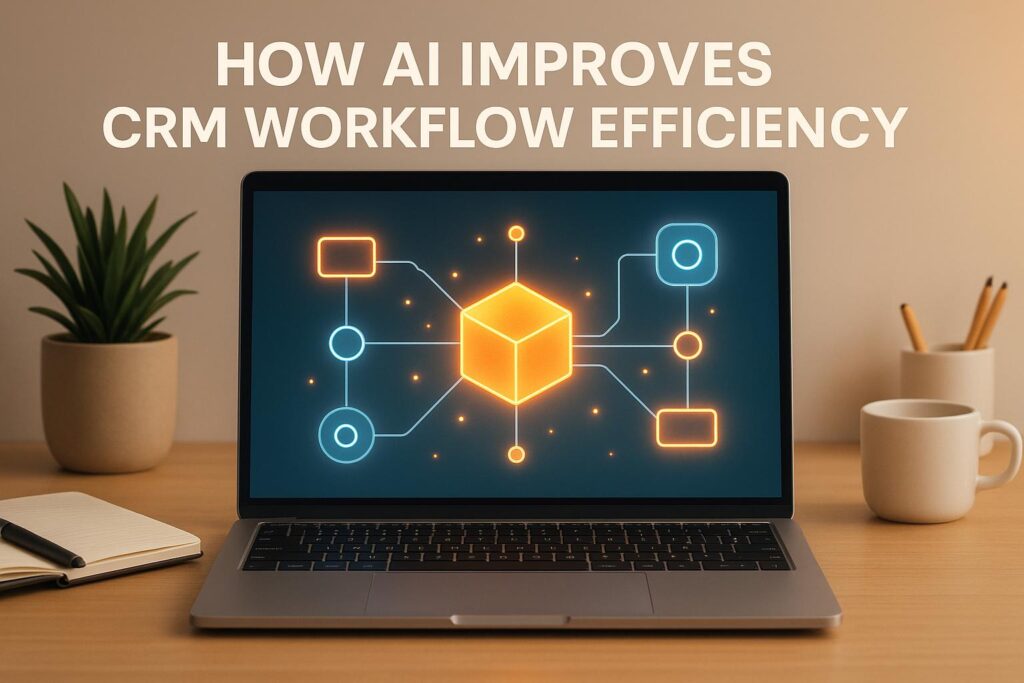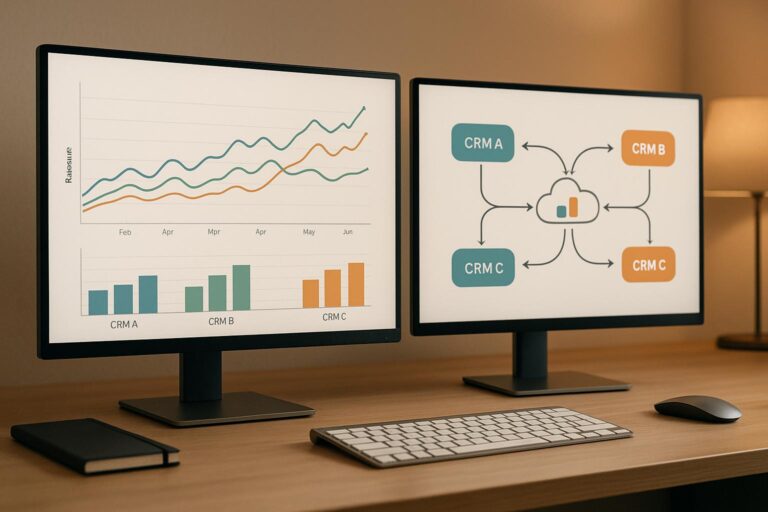AI is transforming CRM workflows by automating repetitive tasks, improving lead management, and ensuring data accuracy. It eliminates common issues like slow response times, fragmented data, and manual errors, allowing businesses to scale without adding complexity. Here’s a quick breakdown of the key benefits:
- Time Savings: AI automates tasks like data entry, lead scoring, and report generation, freeing up teams to focus on high-value activities.
- Smarter Lead Management: AI evaluates complex data points to prioritize leads, improving conversion rates and sales outcomes.
- Improved Customer Engagement: AI personalizes outreach, analyzes behavior, and ensures timely responses, enhancing customer satisfaction.
- Real-Time Insights: Integrated dashboards provide up-to-date metrics, helping teams make informed decisions quickly.
Build an AI Agent to Send Emails & Automate Your CRM with n8n (No-Code Tutorial)
Key Benefits of AI in CRM Workflow Automation
Switching from manual CRM processes to AI-powered automation brings noticeable improvements in efficiency, sales outcomes, and customer satisfaction. These advantages grow alongside your business, offering cost savings, smarter lead management, and better customer engagement.
Cost and Time Savings Through Automation
AI takes over repetitive CRM tasks, turning them into smooth, automated workflows that don’t need human oversight. By handling data entry and maintaining accuracy, AI reduces errors and can easily scale to handle larger workloads as your business grows.
This scalability means teams can shift their focus to strategic priorities instead of spending time on administrative work. As companies expand, the need for extra support staff decreases, and the time saved can be reinvested into improving lead handling and other high-value activities.
Smarter Lead Management and Prioritization
AI transforms lead management into a proactive, data-driven process. Instead of relying on basic demographic information or simple point systems, AI evaluates a wide range of data – such as behavioral patterns and company growth metrics – to identify the most promising opportunities in real time.
For example, AI updates lead scores dynamically based on actions like frequent visits to pricing pages or downloading specific resources. Notion, for instance, achieved an auto-approval rate of about 40% for their startup program using AI-driven lead evaluation. Additionally, AI enables precise segmentation, routing leads based on criteria like industry, company size, or buying habits, ensuring they reach the right specialists for follow-up.
Improved Customer Engagement and Satisfaction
AI doesn’t just save time – it also makes customer interactions more meaningful. By analyzing communication history, purchase behavior, and other data, AI creates responses tailored to individual customer needs. It goes beyond basic personalization by referencing past interactions, addressing previous concerns, and suggesting solutions based on similar success stories – tasks that used to require dedicated account managers.
Speed is another game-changer. While human teams might take hours or days to respond, AI systems can acknowledge inquiries instantly and even resolve common issues on the spot. For more complex problems, AI gathers the necessary context before passing the matter to the most qualified team member.
AI also boosts proactive engagement. By monitoring buying signals from over 3 million companies, AI helps businesses prioritize outreach at the perfect moment. This allows teams to connect with prospects using messaging that aligns with their current needs and circumstances.
Core AI Techniques for CRM Workflow Optimization
AI is reshaping how businesses handle lead management, pipeline oversight, and decision-making. These tools go far beyond simple automation, introducing intelligent systems that learn and adapt over time.
AI for Lead Qualification and Scoring
AI has completely changed how companies qualify leads by analyzing vast amounts of data at once to pinpoint the most promising prospects. Instead of relying on basic demographic filters, AI dives deeper, examining behavioral trends, company growth indicators, and engagement history to create dynamic lead scores that evolve in real time.
Modern tools combine firmographic data (like company size and industry) with behavioral insights (such as website visits and content downloads) to refine lead scores and trigger timely follow-ups. AI also taps into intent data, tracking buying signals across countless companies to detect when prospects are actively researching solutions. Predictive lead scoring takes this further by using both current and historical behaviors to estimate the likelihood of conversion, ensuring sales teams can prioritize the most valuable opportunities.
This enhanced lead scoring is just the beginning – AI also simplifies the sales process by automating pipeline management.
Automating Sales Pipeline Management
Pipeline management has traditionally been a manual, reactive task, but AI has turned it into a smart, proactive system. Leads now move seamlessly through different stages based on specific actions and triggers.
For example, if a lead attends a product demo and downloads a case study within 48 hours, AI can automatically upgrade them to a "qualified opportunity" and launch a personalized follow-up sequence. AI systems also monitor deal health by tracking communication patterns, response times, and engagement levels, flagging deals that might be at risk of stalling. If engagement drops or follow-ups are delayed, the system alerts sales reps and suggests targeted strategies to re-engage the lead.
AI doesn’t stop there – it handles task management too. By generating tasks, scheduling meetings, and drafting personalized emails, it ensures the sales process runs smoothly. With insights into deal velocity and conversion rates, AI helps teams allocate resources wisely, focusing on the opportunities that matter most.
But managing leads and deals is only part of the story. AI also integrates data from multiple platforms to deliver actionable insights in real time.
Data Integration and Real-Time Reporting
AI’s ability to unify data and provide real-time reporting is a game-changer for CRM systems. By integrating information from over 3,000 pre-built applications – including CRMs, marketing automation tools, and third-party enrichment platforms – AI creates a single, constantly updated source of truth.
This real-time processing ensures that every interaction – whether it’s a website visit, an email click, or a webinar attendance – is immediately reflected in the CRM, triggering data-driven actions. AI can simultaneously analyze enrichment data, intent signals, and CRM records, ensuring no detail is missed.
Companies like Anthropic have seen major improvements in their sales workflows through AI-driven data integration. Adam Wall, Head of Revenue Operations at Anthropic, shares:
"Clay has helped Anthropic significantly improve our lead enrichment and sales data pipelines. We’ve been able to consolidate our tech stack to core essentials, like our CRM, Clay, and email tool."
Similarly, OpenAI has used AI-powered tools to accelerate their go-to-market strategies. Scotty Huhn from OpenAI’s Revenue Strategy & Data team notes:
"Clay enables our team to rapidly experiment with trigger driven workflows, and 3rd party enrichment data. We’re able to move fast and drive outsized impact on GTM execution – all while using a tool that’s fun, creative, and cutting edge."
AI also simplifies reporting by creating automated dashboards that provide a real-time view of pipeline health, conversion rates, and revenue forecasts. These updates ensure decision-makers always have the latest insights without the hassle of manual report generation. Predictive analytics further enhance this process, helping teams anticipate challenges and address bottlenecks before they become issues.
sbb-itb-647c22e
Steps to Implement AI-Powered CRM Workflows
Implementing AI-powered CRM workflows requires a well-thought-out plan. The process starts with evaluating your current systems and identifying specific areas that need improvement. Instead of trying to automate everything at once, focus on solving the most pressing issues first.
Finding Workflow Bottlenecks
The first step is to audit your CRM processes and uncover inefficiencies. Begin by mapping your entire sales funnel – from capturing leads to closing deals. Document each manual task and decision point along the way.
Common pain points include duplicate data entry, where sales reps re-enter information already available in other systems. Assess how much time your team spends on administrative tasks versus actual selling activities. Many organizations discover that a significant portion of sales reps’ time is consumed by tasks like data entry and coordinating follow-ups, rather than engaging with prospects.
Another area to examine is handoff points – whether between marketing and sales or within different sales teams. These transitions often cause delays or information gaps that AI can help address. Analyze how quickly leads are followed up on and identify cases where delayed outreach results in missed opportunities.
Standardizing lead qualification is also crucial. Manual lead scoring can vary widely between team members, leading to inconsistent results. By tracking conversion rates for individual reps, you can pinpoint where AI-driven systems might improve outcomes.
Pay attention to data quality issues – such as incomplete contact details, outdated company information, or missing engagement history. These gaps highlight areas where AI-powered tools, like data enrichment solutions, can make an immediate difference. Identifying these inefficiencies is key to selecting tools that will streamline your workflows.
Choosing the Right Tools and Platforms
Selecting the right platform is critical, as it needs to align with your technical requirements, current systems, and long-term goals. AI tools not only automate tasks but also refine processes, so choosing wisely is essential.
Here are some options to consider:
- No-code platforms like Zapier and Make.com: These are ideal for simple automations, such as syncing data between systems or setting up basic follow-up workflows. They’re user-friendly and can be implemented quickly, even by non-technical team members.
- Advanced platforms like n8n: For workflows that require custom logic or more complex data handling, platforms like n8n offer greater flexibility while still providing an intuitive interface.
- Lead enrichment tools like Clay.com: These are perfect for businesses that handle large volumes of prospect data and need to pull information from multiple sources efficiently.
- Custom-coded solutions: If your needs go beyond the capabilities of standard platforms, custom development may be the answer. This approach allows for deeper integration with proprietary systems or the use of specialized AI models tailored to your industry.
- Dashboard and reporting tools like Google Looker and PowerBI: Once your workflows generate significant data, these tools help consolidate information and provide real-time insights into performance.
The choice often depends on balancing speed and customization. Many companies start with no-code solutions for quick wins and gradually adopt more advanced platforms as their needs evolve.
Designing, Testing, and Optimizing Workflows
Once bottlenecks are identified and tools selected, it’s time to design workflows that address your most pressing challenges. Use a build-test-refine cycle to ensure reliability and avoid unnecessary complexity.
Start simple. Focus on single-purpose workflows that address specific problems. For instance, create one workflow to enrich new leads with company data and another to score leads based on engagement. This approach makes troubleshooting easier and allows you to measure the impact of each workflow.
Test your workflows alongside existing manual processes to ensure accuracy and relevance. Don’t forget to account for edge cases, such as incomplete data or unusual lead scenarios, to confirm the system handles exceptions effectively.
Fine-tune triggers and thresholds for optimal performance. If a workflow sends too many notifications, it can overwhelm your team. On the other hand, overly restrictive settings might cause missed opportunities.
During testing, establish data quality monitoring to catch issues early. Set alerts for incomplete workflows and track metrics like lead scoring consistency and automation success rates.
After deployment, focus on continuous improvement. Compare conversion rates for AI-scored leads against manually qualified ones and evaluate the time savings from automation. Start with basic workflows and gradually add complexity, ensuring each new feature delivers measurable benefits before scaling further. Regular refinement will help you maximize AI’s potential to transform your CRM processes.
Real-Time Visibility and Performance Metrics
Keeping an eye on AI-powered CRM workflows is essential to understand their performance and uncover areas for improvement. Without clear visibility, it’s tough to figure out what’s working, what needs tweaking, or where new opportunities might arise. Real-time dashboards and analytics turn raw data into actionable insights, helping you make smarter decisions. These insights lay the groundwork for creating dashboards that highlight the metrics that matter most.
Setting Up Unified Dashboards
Bringing together data from your CRM, marketing automation tools, and AI platforms into a single dashboard is key. Tools like Google Looker and PowerBI make this possible. Focus on critical KPIs such as lead conversion rates, pipeline velocity, and the accuracy of AI-driven lead scoring.
When designing dashboards, consider the needs of different users. For example:
- Sales teams need quick access to insights like lead prioritization to act fast.
- Managers benefit from a broader view, tracking team performance and overall trends.
- Revenue operations teams often require deeper dives into workflow performance and data quality.
AI-powered dashboards can take reporting a step further by automatically flagging anomalies, such as sudden drops in lead quality or unexpected changes in conversion rates. With drill-down features, users can explore high-level metrics in detail – like identifying which campaigns or team members are driving changes in performance.
Tracking ROI and Workflow Impact
Measuring ROI for AI-powered workflows means looking at both cost savings and revenue growth. Start by comparing the time spent on manual tasks before and after automation. Then, connect revenue gains to improvements in lead scoring and faster response times.
AI also sharpens revenue attribution. By automatically scoring and prioritizing leads, you can trace which AI-driven insights led to closed deals. This not only justifies your investment but also highlights the most valuable parts of your workflows.
Take Anthropic, for example. In 2025, they revamped their lead enrichment and sales data processes by integrating Clay into their tech stack. This saved them 4 hours per week by automating inbound lead enrichment and scoring in Salesforce. They also achieved 100% automation of Salesforce opportunity updates, boosting both data accuracy and operational efficiency. These gains were clearly visible in their real-time dashboards.
Another way to measure ROI is by tracking data quality improvements. AI workflows can enhance the completeness and accuracy of your data compared to manual methods. Metrics like the percentage of complete contact records, data freshness, and reductions in duplicate entries are good indicators of progress.
Finally, conversion rate improvements offer a straightforward way to gauge ROI. By comparing conversion rates for AI-scored leads against those manually qualified, many companies see significant boosts in lead-to-opportunity and opportunity-to-close rates after adopting AI workflows.
Continuous Improvement Through AI Insights
AI-driven workflows don’t just run – they evolve. Unlike static processes, AI systems can spot patterns, suggest improvements, and adapt to shifting business needs. Unified dashboards and precise ROI metrics help maintain this cycle of improvement.
Start with performance trend analysis to find areas for refinement. Monitor metrics like lead scoring accuracy, workflow completion rates, and conversion trends. If certain lead sources underperform despite high AI scores, it might be time to rethink scoring criteria or data inputs.
AI also takes A/B testing to another level. You can experiment with different scoring models, enrichment strategies, or automation triggers, measuring their impact on key metrics to ensure every change is backed by solid evidence.
"Clay enables our team to rapidly experiment with trigger-driven workflows and third-party enrichment data. We’re able to move fast and drive outsized impact on GTM execution – all while using a tool that’s fun, creative, and cutting-edge."
– Scotty Huhn, Revenue Strategy & Data, OpenAI
Keep an eye out for workflow bottlenecks, especially as your business grows. Some automation steps might slow down or lose effectiveness over time. Regular performance reviews can help you catch and address these issues early.
Incorporate sales feedback to refine AI models further. Insights from sales reps about lead quality or workflow effectiveness can improve future performance when fed back into the system.
Lastly, consider using predictive analytics to stay ahead of the curve. AI can identify early warning signs like declining lead quality or shifting customer behavior, giving you the chance to tackle challenges before they escalate.
Regular audits of your workflows ensure they stay aligned with your business goals. As your company evolves, workflows that worked six months ago might need adjustments. Monthly or quarterly reviews can help keep your AI investments on track and delivering the best results.
Conclusion: The Future of AI in CRM Workflow Efficiency
AI is revolutionizing CRM workflows by turning manual processes into systems that are faster, smarter, and more effective. The result? Tangible improvements in cost savings, operational efficiency, and customer engagement.
Key Takeaways from AI-Driven Workflow Optimization
AI doesn’t just automate tasks – it integrates data to provide real-time insights and ongoing improvements. By cutting down on manual tasks like lead qualification and data entry, businesses save time and allow teams to focus on what matters most: high-value opportunities. Improved data accuracy eliminates errors often seen in manual workflows, and AI’s scalability ensures smooth operations even as business demands grow.
With real-time access to performance metrics, companies can adapt quickly to market changes and make informed decisions on the fly. By automating repetitive tasks, AI allows sales teams to focus on building relationships and closing deals, while marketing teams can prioritize strategy and creativity.
How SixtySixTen Can Help

SixtySixTen is here to help you unlock the full potential of AI in your CRM workflows. We specialize in helping post-PMF B2B SaaS companies scale by replacing manual revenue processes with automated systems designed for efficiency and growth.
Our approach combines no-code platforms like n8n, Clay.com, and Make.com with custom development tailored to your business needs. Here’s how we can assist:
- AI agents for tasks like prospecting, lead scoring, and sales enablement
- Automated workflows to eliminate repetitive tasks across CRM, email, ads, and reporting
- Custom-coded solutions for unique business challenges
- Unified dashboards with tools like Google Looker and PowerBI for real-time visibility into go-to-market performance
From the discovery phase to implementation and ongoing support, we work alongside you to create AI-driven CRM systems that fuel sustainable growth. Whether you’re tackling lead qualification bottlenecks, pipeline management inefficiencies, or data integration hurdles, SixtySixTen provides the expertise and tools needed to thrive in today’s fast-paced market.
FAQs
How does AI make lead scoring more accurate and efficient in CRM workflows?
AI is reshaping lead scoring by processing massive amounts of data in real time, uncovering patterns and insights that traditional methods often overlook. By leveraging machine learning, it can predict lead quality with greater precision, drawing from historical data, engagement trends, and other key indicators.
With these capabilities, AI-powered CRM systems can automate tasks like prioritizing leads, segmenting audiences, and tailoring outreach efforts. This streamlines workflows, saves valuable time, and ensures sales teams concentrate on the most promising opportunities – boosting productivity and improving outcomes throughout the sales process.
What steps should a company take to successfully implement AI in their CRM workflows?
To make AI work effectively in CRM workflows, start by pinpointing repetitive tasks that can be automated. These might include data entry, lead scoring, or scheduling follow-ups. Then, look at areas where AI can help create more personalized experiences, such as customizing communication based on customer preferences or behavior.
AI tools can also simplify processes like lead enrichment, customer segmentation, and pipeline management. Choose tools that integrate effortlessly with your current CRM system to ensure a smooth transition and avoid disruptions. By starting with small, manageable changes and scaling up gradually, businesses can refine their workflows and boost efficiency without putting unnecessary strain on their teams.
How can businesses evaluate the ROI of AI-powered CRM automation?
To evaluate the ROI of AI-powered CRM automation, it’s essential to track metrics that showcase improvements in productivity and efficiency. Start by looking at sales performance – things like the number of deals closed or how quickly leads move through the pipeline. These indicators can give you a clear picture of how automation impacts sales outcomes.
Another key area to assess is the reduction in manual tasks. By automating repetitive processes, your team can shift their focus to more strategic, high-value activities, which often leads to better overall results.
AI tools also boost operational efficiency by simplifying workflows, removing bottlenecks, and improving data accuracy. Over time, these efficiencies not only make daily operations smoother but also support faster scaling and steady growth. This makes it easier to calculate the long-term benefits of your investment in automation.



